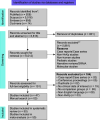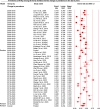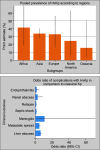Prevalence, Risk Factors, and Clinical Outcomes of Hypervirulent Klebsiella pneumoniae Strains among Klebsiella pneumoniae Infections: A Systematic Review and Meta-analysis
- PMID: 40322229
- PMCID: PMC12045058
- DOI: 10.5005/jp-journals-10071-24957
Prevalence, Risk Factors, and Clinical Outcomes of Hypervirulent Klebsiella pneumoniae Strains among Klebsiella pneumoniae Infections: A Systematic Review and Meta-analysis
Abstract
Aim and background: Hypervirulent Klebsiella pneumoniae (HvKp) is a virulent strain associated with invasive infections. While initially community-acquired, hospital-acquired HvKp (HA-HvKp) and carbapenem-resistant HvKp (CR-HvKp) are increasingly reported. This meta-analysis evaluates the prevalence, risk factors, and clinical outcomes associated with HvKp, including CR-HvKp and HA-HvKp, among Kp infections.
Methodology: A systematic search of PubMed, Scopus, Embase, and Cochrane Library was conducted until December 2024. Observational studies comparing HvKp vs classical Kp (cKp), CR-HvKp vs carbapenem-sensitive HvKp (CS-HvKp), and HA-HvKp vs community-acquired HvKp (CA-HvKp) were included. Quality was assessed using the Joanna Briggs Critical Appraisal Tool, and pooled prevalence and odds ratios (ORs) with 95% confidence intervals (CIs) were calculated.
Results: Fifty studies with 6,663 participants were included. The HvKp prevalence was 33.0%, with most studies from Asia, predominantly China. Temporal analysis revealed an increase in HvKp prevalence (27.7% in 2006-2018 to 38.5% in 2019-2024). The CR-HvKp prevalence rose from 9.5% to 16.5% (2016-2024). The HA-HvKp prevalence increased from 25.9 to 47.1%. Key risk factors included diabetes mellitus (OR = 1.56), CA-Kp (OR = 2.59), and hypermucoviscous (HM)-phenotype (OR = 29.79). Complications included liver abscess (OR = 6.35), metastatic spread (OR = 4.74), meningitis (OR = 11.14), and septic shock (OR = 1.30). Mortality was higher in HvKp infections but not statistically significant (p = 0.219). HA-HvKp and immunosuppression were significant CR-HvKp risk factors, with CR-HvKp showing higher mortality.
Conclusions: Diabetes mellitus, CA-Kp infections, and HM-phenotype are significant risk factors for HvKp. The rising prevalence of CR-HvKp and HA-HvKp highlights the need for early detection, infection control, and targeted treatment strategies.
How to cite this article: Nagendra D, Chaudhuri S, Gupta N, Shanbhag V, Eshwara VK, Rao S, et al. Prevalence, Risk Factors, and Clinical Outcomes of Hypervirulent Klebsiella pneumoniae Strains among Klebsiella pneumoniae Infections: A Systematic Review and Meta-analysis. Indian J Crit Care Med 2025;29(4):370-393.
Keywords: Carbapenem-resistant; Clinical outcomes; Hospital-acquired infections; Hypervirulent Klebsiella pneumoniae; Prevalence; Risk factors.
Copyright © 2025; The Author(s).
Conflict of interest statement
Source of support: Nil Conflict of interest: NoneConflict of interest: None
Figures





Similar articles
-
Clinical and molecular characteristics of multi-clone carbapenem-resistant hypervirulent (hypermucoviscous) Klebsiella pneumoniae isolates in a tertiary hospital in Beijing, China.Int J Infect Dis. 2015 Aug;37:107-12. doi: 10.1016/j.ijid.2015.06.023. Epub 2015 Jun 30. Int J Infect Dis. 2015. PMID: 26141415
-
In vitro activity of cefiderocol, a siderophore cephalosporin, against carbapenem-resistant hypervirulent Klebsiella pneumoniae in China.Antimicrob Agents Chemother. 2023 Dec 14;67(12):e0073523. doi: 10.1128/aac.00735-23. Epub 2023 Nov 28. Antimicrob Agents Chemother. 2023. PMID: 38014944 Free PMC article.
-
Prevalence of Carbapenem-Resistant Hypervirulent Klebsiella pneumoniae and Hypervirulent Carbapenem-Resistant Klebsiella pneumoniae in China Determined via Mouse Lethality Tests.Front Cell Infect Microbiol. 2022 Jun 1;12:882210. doi: 10.3389/fcimb.2022.882210. eCollection 2022. Front Cell Infect Microbiol. 2022. PMID: 35719357 Free PMC article.
-
"Superbugs" with hypervirulence and carbapenem resistance in Klebsiella pneumoniae: the rise of such emerging nosocomial pathogens in China.Sci Bull (Beijing). 2023 Nov 15;68(21):2658-2670. doi: 10.1016/j.scib.2023.09.040. Epub 2023 Sep 29. Sci Bull (Beijing). 2023. PMID: 37821268 Review.
-
Hypervirulent Klebsiella pneumoniae (hvKp): Overview, Epidemiology, and Laboratory Detection.Pathog Immun. 2025 Jan 24;10(1):80-119. doi: 10.20411/pai.v10i1.777. eCollection 2024. Pathog Immun. 2025. PMID: 39911145 Free PMC article. Review.
References
-
- Pathak A, Tejan N, Dubey A, Chauhan R, Fatima N, Singh SJ, et al. Outbreak of colistin resistant, carbapenemase (blaNDM, blaOXA-232) producing Klebsiella pneumoniae causing bloodstream infection among neonates at a tertiary care hospital in India. Front Cell Infect Microbiol. 2023;13:1051020. doi: 10.3389/fcimb.2023.1051020. - DOI - PMC - PubMed
LinkOut - more resources
Full Text Sources
